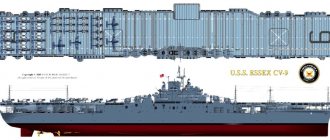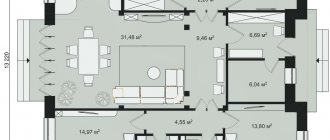For the term "Soviet Union" see also other meanings.
| Type "Soviet Union" | |
| Project | |
| A country |
|
| Main characteristics | |
| Displacement | standard 59,150 t full 65,150 t |
| Length | 269.4 m (260.0 m by vertical line) |
| Width | 38.9 m (36.4 m along the vertical line) |
| Draft | 10.19 m |
| Booking | armor belt: 375-420 mm, bulkheads: 230-365 mm, barbette: 425 mm, gun turrets: 495 mm, deck: 25+155+50 mm, wheelhouse: 425 mm |
| Engines | 6 triangular boilers |
| Power | 201,000 l. With. |
| Travel speed | 29 knots maximum 28 knots cruising |
| Cruising range | 7200 miles |
| Sailing autonomy | 30 days |
| Crew | 1226 sailors, 66 officers |
| Armament | |
| Artillery | 3×3 406.4/50 mm AU B-37 6×2 152 mm |
| Flak | 6×2 100 mm 10×4 37 mm 46-K |
| Aviation group | 4 KOR-2 aircraft, 2 catapults. |
| Media files on Wikimedia Commons | |
Project 23 battleships
(type
"Soviet Union"
) - a project of battleships built for the USSR Navy in the late 1930s - early 1940s as part of the construction program of the "Large Sea and Ocean Fleet". It was believed that the new battleships would be the largest and most powerful in the world. None of the laid down ships of the project could be completed and included in the Soviet fleet.
Content
- 1 Development history 1.1 Decision making to create a new type of ship
- 1.2 Final approval of the project
- 3.1 Hull and superstructure design 3.1.1 Armor
- 3.2.1 Characteristics of the power plant
- 4.1 Artillery weapons
- 7.1 References
Cooperation with India
Based on the PAK FA "Sukhim" together with the Indian company Hindustan Aeronautics Ltd. (Hindustan Aeronotics Limited) Since 2010, the development of a joint Russian-Indian fifth-generation fighter project FGFA (Fifth Generation Fighter Aircraft, “fifth generation fighter”) has been underway. In April 2022, Jane's Defense Weekly reported that India was withdrawing from the FGFA project, while claiming that the Indian side may reconsider this decision or purchase export Su-57s after the aircraft enters service with the Russian Aerospace Forces. No official comments from the Russian side on the status of the FGFA project have been published.
Development history
Making a decision to create a new type of ship
The combat regulations of the Red Army Naval Forces - 1930 (BU-30) recognized battleships as the main striking force of the fleet, and the course towards industrialization opened up real prospects for their creation. The technical design of the battleship was completed by the end of April 1937. However, its approval and the laying down of the first two ships ordered on November 22, 1936 to the Baltic Shipyard did not take place. At the end of May 1937, the standard displacement was increased to 55,000 tons, changing the original design.
Final approval of the project
Initially, the completion date for the design work was scheduled for October 15, 1937, but “project 23” was finally approved by a resolution of the Defense Committee of the Council of People's Commissars of the USSR only on July 13, 1939, when the lead ship was already laid down.
The planned cost of the first four ships of the project (1.18 billion rubles[1]) was equal to almost a third of the country's annual naval budget in 1940[2].
Project history
The design of a promising multirole fighter to replace the Su-27 and MiG-31 began in the USSR in the late 1970s. On July 5, 1981, a resolution was issued by the Central Committee of the CPSU and the Council of Ministers of the USSR on a targeted comprehensive program for the creation of such aircraft.
At the end of the 1990s, the victory in the competition for the creation of a promising 5th generation front-line aviation complex (PAK FA) for the Air Force (Air Force, now part of the Aerospace Forces, VKS) of Russia was won by the Sukhoi Experimental Design Bureau ( now a branch of PJSC "). The project of the aircraft, designated T-50 (aviation complex I-21), has been developed since 1999. The draft layout was ready by the fall of 2004.
The Komsomolsk-on-Amur Aviation Plant named after Yu. A. Gagarin, part of Sukhoi, was identified as the site for the construction of aircraft. By 2009, two prototypes had been produced for ground testing.
The first flight prototype of the T-50 took off on January 29, 2010, piloted by test pilot Sergei Bogdan.
The PAK FA was created as a single-seat attack aircraft; composite materials are widely used in its design. The vehicle must meet all the requirements set by the Russian Aerospace Forces for 5th generation fighters: supersonic flight without afterburner, low visibility (for radar, optical, acoustic and other detection systems), super maneuverability and the ability to make relatively short takeoffs and landings. The flight characteristics of the aircraft are not disclosed, the maximum take-off weight is estimated by experts at 35 tons, the cruising speed is Mach 1.7-1.8, the maximum is Mach 2-2.5, the range is 4 thousand km. Armament - air-to-air and air-to-surface missiles or aerial bombs; 30 mm caliber air cannon. To reduce radar signature, it is planned to place weapons in the intra-fuselage compartments, however, the use of underwing pylons for external sling was also tested on flight prototypes.
History of construction
In general, under Project 23, a colossal amount of development work was carried out (more than a hundred models were built) and various tests, including: experimental bombing of a converted dry cargo ship (appropriate deck protection was installed), simulating explosions on mines and torpedoes (more thirty scale and two full-scale). Protection against proximity fuses was created - a demagnetizing device, designed at LPTI in 1936-37 and subsequently used on ships of all classes. In addition, slipways and outfitting and emergency docks were prepared at the Baltic and Nikolaevsky factories. Thus, the process of designing these battleships gave a powerful impetus to the creation of large ships at domestic shipyards.
The lead battleship "Soviet Union", serial number S-299, was laid down in Leningrad at the Baltic Shipyard. This is evidenced by the official report:
“To the Head of the Shipbuilding Department of the RKKF, Flag Officer 3rd Rank Comrade Gorshkov. I hereby inform you that on July 15, 1938, the Soviet Union aircraft was laid down at the S. Ordzhonikidze plant. Military engineer 1st rank authorized by the Criminal Code Kudzi"
In 1938-1939, three more battleships were laid down at two other enterprises: “Soviet Ukraine” (S-352) in Nikolaev, “Soviet Russia” (S-101) and “Soviet Belarus” (S-102) in Molotovsk.
In October 1940, an order was given to suspend the construction of the ship “Soviet Belorussia”, which was 1% complete, and to concentrate the main efforts on the ship “Soviet Union”[3]. Due to the outbreak of the Great Patriotic War, the construction of battleships was stopped (the readiness of the "Soviet Union" was 19.44%, the "Soviet Ukraine" - only 7%), and at the end of the war the unfinished ships were dismantled.
Educational project “FEBRUARY 23 DEFENDER OF THE FATHERLAND DAY”
Educational project
“FEBRUARY 23 DEFENDER OF THE FATHERLAND DAY”
(short)
Duration: 2 - 3 weeks.
Relevance of the project:
Due to recent changes, the loss of traditional Russian patriotic consciousness in our society has become increasingly noticeable. In this regard, the urgency of solving the most pressing problems of instilling patriotism in working with preschool children is obvious. Historically, love for the Motherland and patriotism have always been a national character trait in the Russian state. An equally important condition for the moral and patriotic education of children is a close relationship on this issue with their parents. Interaction with parents promotes respect for traditions and preservation of family ties. Currently, this work is relevant and especially difficult, requiring great tact and patience, since in young families the issues of instilling patriotism and citizenship are not considered important and often only cause bewilderment.
Objective of the project:
- developing a sense of patriotism in children of senior preschool age;
- involving parents in participating in the life of the kindergarten.
Project objectives:
- give children knowledge about the Russian army, clarify their ideas about the branches of the military;
- develop children's cognitive activity and creative abilities;
- continue to instill in children patriotic feelings for the Motherland and pride in our history;
- develop and enrich children’s speech, increase erudition and intelligence;
- work with parents, involving them in the patriotic upbringing of children in the family.
Project participants: music director, senior preschool children, parents of students, group teachers.
Problem:
lack of interest in the Russian army.
Justification of the problem:
- insufficient level of knowledge about the Russian army;
- Lack of desire to become a defender of the Fatherland in the future.
Expected result:
- increasing children's knowledge about the Russian army.
- children showing interest in the army and respect for the defenders of the Fatherland.
- children's desire to improve physical qualities and improve health.
- the desire of children to reflect their knowledge, impressions, thoughts and feelings in games, in singing songs, in reading poetry.
- increasing the interest of parents in developing a sense of patriotism in children.
Project implementation:
February 2022.
Project implementation mechanism:
I
:
Preparatory.
- Formulation of project goals and objectives
- Studying literature on the project topic
- Studying Internet resources on the project topic
- Analysis of the subject environment of the group.
- Project development.
- Inform project participants of the importance of this problem.
- Select methodological, popular science and fiction literature, illustrative material on this topic.
- Thinking through creative tasks for children and parents.
- Select materials, toys, attributes for gaming and theatrical activities.
- Preparations for the holiday dedicated to Defender of the Fatherland Day.
II
:
Project implementation.
- Conducting conversations with children about the Russian army, about the defenders of our Motherland.
- Conducting outdoor, didactic, role-playing games, sports entertainment.
- Reading fiction to children (memorizing poetry).
- Examination of illustrations, learning songs, dance compositions, theatrical skits, watching fragments of videos and presentations.
III
:
Results.
- Holding the holiday “February 23 – Defenders of the Fatherland Day”;
- Involving parents to participate in the life of the kindergarten;
- Presentation “February 23 – Defenders of the Fatherland Day.”
Productive activities:
- design of the exhibition “Military Equipment”;
- learning songs about the army
- presentation “February 23 – Defenders of the Fatherland Day”;
- Holiday "February 23 - Day of Defenders of the Fatherland."
Speech development:
- conversations with children on the topic “There is such a profession - to defend the Motherland.”
- thematic classes “We sing glory to the defenders of the Motherland!”, “We will serve in the army”;
- memorizing poems for the holiday “February 23 – Defenders of the Fatherland Day.”
- reading the stories of L. Kassil “Your Defenders”, Y. Ilyinsky “On Earth, in Heaven and at Sea”, V. Tyurin “We Ride, Swim, Fly”, A. Mityaev “Why is the army dear?”;
- acquaintance with the service of border guards, sappers, sailors, paratroopers.
- viewing and conversation based on Vasnetsov’s painting “Bogatyrs”;
- listening to a fragment from A. Borodin’s symphony “Bogatyr Symphony”;
- viewing illustrations, photographs;
- learning songs, theatrical skits about the Motherland, about the army;
Social development
:
- exhibition of drawings “My dad is the best”;
- watching videos and presentations “Defenders of the Fatherland”.
Game activity:
- plot-role-playing games “We are sailors”, “Border security”, “Pilots”, “At the combat post”;
- didactic games “Military professions”;
- re-enactment “At the Battle Post”;
- outdoor game "Secret Report".
Solving problems with parents:
- Joint design of a photo collage dedicated to Defender of the Fatherland Day with photographs of dads while serving in the army.
- Design of stand information, congratulations on the holiday.
- Consultation – “The history of the holiday on February 23.”
- Organization of an exhibition of joint works on the topic of the project.
- Holiday dedicated to Defender of the Fatherland Day
Solving problems with children:
PROJECT ACTIVITY PLAN WITH CHILDREN
Monday
- Music Learning the song “Our Motherland”
- Cognition "Military professions"
Tuesday
- Conversation “Russian Armed Forces”
Wednesday
- R.r. Learning poems dedicated to Defender of the Fatherland Day.
- Modeling “Dogs guarding the Motherland”
- Phys. on the street "Game of paratroopers"
Thursday
- Construction of the "Court".
- Music learning the dance “Procession with flags”
- Story-based role-playing game “Sister of Mercy”
Friday
- Hood. lit. L. Linkov “Stories about border guards”
- Rice. "Our Army"
Second week
Monday
- Rice. "My dad is the best"
- Cognition "Russian Army"
Tuesday
- Role-playing game "Russian Army"
- Phys. "Three Tankers"
Wednesday
- Modeling applique “Gift for February 23rd”
- Examination of illustrations depicting various branches of the military.
Thursday
- Construction "Military equipment"
- Music Learning the song “Good Soldiers”
Friday
- Conversation “Good Soldiers”
- Rice. "Warship"
- Phys. "Submarine"
Third week
Monday
- Role-playing game "Pilots"
- Final conversation “What do I know about the army”
Tuesday
- Holiday dedicated to Defender of the Fatherland Day
Solving problems with children outside of class:
- Examination of paintings with images of pilots, infantrymen, tank crews, sailors;
- Conversation “Monuments of military glory”;
- Learning songs and poems.
Productive activities outside of class:
-Artistically handmade work “Gifts for Dads and Grandfathers”;
Game activity:
- Role-playing games “Scouts”, “Sailors”;
-Didactic games “Lay it out and name it
correctly”, “Do you know?”, “Assemble a car”, lotto “Military equipment”.
-Outdoor games “Signal flags”, “Three tankmen”, “Submarine”
Planned result:
At the end of the project, children will more often use military themes for games, speak respectfully of the defenders of the fatherland, and proudly share with their peers and teachers the knowledge they received from their parents about serving in the army. They will play board, printed and didactic games with great interest. Develop cognitive and creative skills, communication abilities.
Design
The unsinkability of the ship was ensured when the unarmored part of the ship was destroyed and two 21-inch torpedoes were simultaneously hit in the bottom or three torpedoes in the boules. Much attention was paid to the quality and strength of connecting armor plates in various ways: with rivets in three rows in a checkerboard pattern, with dowels, etc. The possibility of using welding was considered, which gradually became part of the practice of Soviet and foreign shipbuilding (welded armor decks with a thickness of 12– 30 mm German cruisers of the Admiral Hipper type). Based on the results of a war game held in 1938 at the Naval Academy with training shooting on a training stand, it was believed that Soviet ships of Project 23 would have advantages over foreign battleships. At the same time, the conclusion was made about the “benefit of the 85-105 mm caliber for anti-aircraft artillery,” which subsequently required significant clarification.
Hull and superstructure design
Booking
armor belt: 375—420 mm, belt height 6.27 m, tilt angle 5°,
bulkheads: 230-365 mm,
barbette: 425 mm,
gun turrets: 495 mm,
deck: 25+155+50 mm,
deckhouse: 425 mm
Anti-torpedo protection
Anti-torpedo protection was designed for a charge explosion of up to 750 kg of TNT equivalent. The anti-torpedo protection had a length of slightly less than 70% of the ship’s length along the vertical line. Over most of its length, its depth was at least 7.5 m (at the midships - 8.2 m) and only at the bow traverse of the citadel (the 64th frame) it decreased to 7.1 m. In the aft part of the citadel, for design reasons, instead The Italian system was used in favor of the American one with four longitudinal bulkheads. For an objective comparative assessment of various protection systems, in 1937-1938 a series of experiments was carried out in Nikolaev with the detonation of 24 large-scale (1:5) compartments manufactured by Plant No. 200 of seven systems known at that time. The results of these tests, carried out by the commission of Captain 2nd Rank Lundyshev, selected the two most effective ones: the American one, used on the battleship West Virginia, and the Italian Pugliese-Littorio class. Based on these results, in February 1938 they proposed replacing the Italian system with an American one on the Project 23 ship, considering it more preferable, both in terms of explosion resistance and design and operational qualities. The proposal was rejected due to fears that the rework would delay the ship's laying date.
Power plant
The ship's power plant included three main turbo-gear units (GTZA) with a capacity of 67,000 hp each. With. (maximum 77,000 hp) and six water-tube boilers.
Characteristics of the power plant
The steam output of one boiler is 162 t/h (maximum 185 t/h), outlet pressure 37 atm. at a temperature of 380. The GTZ of the battleship was unified with the units of the Project 69 heavy cruiser.
Engines of the first and second stages, tests
The experimental and first production samples of the fighter are equipped with the Izdeliye 117 propulsion system developed by NPO Saturn (Rybinsk, Yaroslavl region; Su-35 fighters are equipped with similar engines). The engine of the second stage - the so-called product 30 - has been undergoing bench tests since 2016. It is assumed that the “product 30” will allow the fighter to reach supersonic speed without the use of afterburner.
In 2010-2013, factory tests of the T-50 were carried out, and state joint tests began. Test flights took place in the Moscow region (at the M. Gromov Flight Research Institute) and at the 929th State Flight Test Center of the Russian Air Force named after. V. Chkalov in Akhtubinsk (Astrakhan region)
On July 20, 2022, Commander-in-Chief of the Russian Aerospace Forces Viktor Bondarev announced the completion of the first stage of state testing of the T-50. On August 11, 2017, Bondarev, in an interview with the website of the Russian TV channel Zvezda, said that the T-50 (PAK FA) received the serial name Su-57. The start of deliveries of the aircraft to the troops was expected in 2022.
On December 5, 2022, the Ministry of Industry and Trade of the Russian Federation reported that on the same day at the Leningrad Institute named after. M. M. Gromov made the first flight of the T-50 with the second stage engine. The fighter was flown by Sergei Bogdan. The flight duration was 17 minutes, it was carried out normally, in accordance with the conditions of the mission.
On March 1, 2022, Russian Defense Minister Sergei Shoigu told reporters that two Su-57s completed a two-day test program in Syria. According to the minister, the tests, including combat ones, “were successful.” On December 18, 2022, Chief of the General Staff Valery Gerasimov announced that the Su-57s were retested in Syria. During it, all planned tasks were also completed.
Armament
Artillery weapons
The artillery armament of the battleships was to consist of nine 406-mm main-caliber guns in three turrets, twelve 152-mm guns in six two-gun turrets, as well as eight 100-mm anti-aircraft guns in four twin turrets and thirty-two 37-mm anti-aircraft guns in quadruple turrets. nest installations.
The 406-mm B-37 naval gun was specially developed for battleships. Due to the cessation of the construction of battleships of the "Soviet Union" type in July 1941, work on the creation of the B-37 gun and the MK-1 turret for it was stopped, but one of the experimental B-37 guns took part in the defense in 1941-1944 Leningrad from German troops and as part of battery No. 1 of the Scientific Research Naval Artillery Range supported the troops of the Leningrad and Volkhov fronts in various directions.
“Russia is my history”: a large-scale project in 23 cities
"Russia - My History." The exhibition project has grown over several years and is already present in 23 cities of Russia - from Moscow to Vladivostok and Sakhalin. It is especially important that historical parks are growing in Siberia and the Far East, uniting Russia with a common understanding of a common past. Full presence effect. And unlike ordinary museums, in the “Russia – My History” park you can touch the exhibits with your hands and even taste them.
Where else, if not in Vladivostok, on the shore of the Sea of Japan with a view of the supports of the beautiful Golden Bridge, will the historical park “Russia - My History” appear? The youngest, the most modern. The 23rd in the country, it has only been open for a month and has already celebrated its first thousand visitors. And this is during a pandemic. Borders are awaiting opening here: Vladivostok is like a window to Russia for tourists from Asia.
“We have a guide who speaks Korean. We have Chinese in our audio guides. Therefore, we, of course, are really looking forward to when this situation is resolved, ends, and we are ready to receive foreign tourists,” said Roman Mikhailov, head of the excursion service of the Russia is My History park in Vladivostok.
This is a historical park, not a museum. No fences, exhibits under glass; You can’t just touch electronic panels, you have to. Sometimes all it takes is not even a touch, but a wave of the hand. A living story that even a child can understand.
We all remember how battle plans were depicted in school history books - maps with arrows. Many still did not understand who was attacking whom and from where. Here everything is extremely clear. The Battle of the Ice, the Battle of Kulikovo - just raise your hand to the screen and you will see a full reconstruction of the battle.
In the halls of the park are the Rurikovichs, the Romanovs, the great upheavals and the Great Victory of the 20th century, the years of the Soviet Union and Russia today. Not a single date, not a single statement, not a single detail is missed here. For example, the image of the Russian bear as a personification of the power of Russia has been in use since the 16th century - Europeans, with fear and anger, portrayed Ivan the Terrible this way.
The West's attacks on Russia are not new, but rather a trend. One of the stands contains the main anti-Soviet cartoons of the 20th century. Let's take the period from the mid-60s to the early 80s: the space race, the boycott of the 1980 Olympics, the Afghan campaign. And so - with almost every page in the living historical chronicle. The circular labyrinths of the park's halls are a symbol of the cyclical nature of history.
“Ignorance of history very often turns into tragedies for our people. After all, as the Holy Scripture says, there is nothing new under the sun. What was, is what will be,” noted Tikhon (Shevkunov), Metropolitan of Pskov and Porkhov, abbot of the Pskov-Pechersk Monastery.
23 historical parks across the country are twins when it comes to the overall history of Russia. But each has unique regional content. For example, guests from other regions in the Yakutsk park will definitely be invited to the table and treated to a national dish. Here they experiment in the kitchen every week. Culinary traditions are also history. The exhibition here goes beyond the halls - sculptures of totem animals for the Sakha Republic are located near the museum building. The indispensable mammoth, horse and – most importantly – a bull.
“For the Yakuts, this is a symbol of cold, we can’t wait for the first horn to fall off, this should happen for us at the end of January, when the bitter winter ends, otherwise we’ve had 50-degree frost for a month and a half already,” said Dmitry Soloviev, director of the historical park “Russia is my history” in Yakutsk. The sculpture will remain intact: the horns, and then the body, disappear from the mythical bull. He is like the personification of winter, melting more and more as spring days approach.
On Sakhalin, audio guides require Japanese. And regional history, too, with an accent from the Land of the Rising Sun. After all, until 1945, part of the island was a Japanese prefecture. The photo shows examples of architecture from the times when Yuzhno-Sakhalinsk was called Toehara. The buildings have survived to this day. And so - in every historical park in Russia. Residents of neighboring regions will definitely discover something new.
For example, not all residents of the European part of the country know that Vladivostok was created as a fortress city, but on the pages of this book its history literally comes to life. Here, for example, is the Voroshilov battery, one of the most modern in the Vladivostok fortress, built in the 30s of the last century. The battery is located so that any ship that comes closer than 41 kilometers to Russky Island falls under its sights. And most importantly, the towers of Voroshilovka were almost always covered in thick fog, like today. So the enemy did not see where the fire was coming from. And his ships were in full view. Fortunately, these guns were never fired at a real enemy.
And here is a completely unique photo - young Nicholas II, then still the Tsarevich, carrying earth in a cart for laying the Trans-Siberian Railway. In 1891, in Vladivostok, he initiated the construction of a railway line. From such bright, living fragments the incredible exhibition of the parks “Russia - My History” is woven. And there is another transformation ahead: the parks will become educational centers for schoolchildren, which will open on these sites in the spring.
“The site of historical parks will allow schoolchildren to freely communicate on various topics and understand that we live in a beautiful country, we have a rich history,” said Minister of Education Sergei Kravtsov.
In Crimea, a historical park will be created on the basis of Artek. Very soon. “Russia – my history” will appear in Pskov. Technically, it will, of course, be superior to the first multimedia parks, but the essence will remain the same. Only with this approach will the expression about the Ivans not remembering kinship sink into oblivion. And it will be saved only on the touch panels of the “Russia is my history” parks.
Comparison with analogues
Comparison of designs of actually built battleships with a standard displacement of more than 50,000 tons.
| Yamato (Japan) | Soviet Union Ave. 23 (USSR) | H39 (Germany) | Montana (USA) | |
| Year of laying | 1937 | 1938 | 1939 | 1941 |
| Displacement standard t | 62,315 (project) 63,200 (real) | 59,150 (project) 60,190 (estimate) | 53,489 (project) | 60,500 (design) |
| Displacement total t | 69,998 (project) 72,810 (real) | 65,150 (project) 67,370 (estimate) | 63,596 (project) | 70,500 (project) |
| Length m | 269,4 | 243,9-263 | 266-277,8 | 281,9 |
| GEM | 4 TZA 12 PK 150,000 l. With. | 3 TZA 6 PK 201/231 000 l. With. | 3-shaft 12 design. 148,000 l. With. | 4 TZA 8 PK 172,000 l. With. |
| Travel speed, knots | 27,5 | 28/29 | 30,4 | 28 |
| Reservations: | ||||
| Main belt | 410 mm | 375—420+20 mm | 180—320+bevel 120mm | 406mm |
| Upper belt | No | 180—420 mm | 150+25 mm | No |
| Bottom belt | 100—170 — 200—270 mm | No | No | 95-210 mm |
| Armor at extremities | No | up to 285—365 mm | up to 150 mm | No |
| Deck armor | main 200—230 mm | 25+155+50 mm | 50-60+100-150 mm | 57+147-186+25 mm |
| Towers (front/side/roof/rear): | 650/250/270/460 mm | 495/230/230/410 mm | 400/220/180-220/325 mm | 560/254/233/370 mm |
| Weapons: | ||||
| Guns | 9-460/45 12-155/60 12-127/40 24- 25 | 9-406/50 12-152/58 12-100/56 40-37 | 8-406/52* 12-150/55 16-105/65 16-37 | 12-406/50 20-127/54? 32-40/56 20-20 |
| Main battery salvo weight | 13,140 kg | 9972 kg | 8240 kg* | 14,696 kg |
- * The 40.6 cm/52 (16″) SK C/34 gun was essentially the 42 cm/48 (16.5″) SK C/40. Being adjusted to the maximum caliber allowed by the treaties, by artificially thickening the inner wall and through a simple boring procedure, it easily returned to the design caliber with an increased projectile mass. In this case, the side salvo of the main battery would exceed 9.1 tons.
Contracts for supplies to troops, mass production
On August 22, 2022, at the Army-2018 forum, the Russian Ministry of Defense and Sukhoi PJSC signed a contract for the supply of two production copies of the Su-57 by 2022. On the same day, Deputy Minister of Defense of the Russian Federation Alexei Krivoruchko told reporters that the first production aircraft “will come to the Armed Forces next year.” UAC head Yuri Slyusar said at the forum that the Su-57 will become the basis for a whole family of aircraft.
On December 6, 2022, a TASS source in the aircraft industry reported that the Su-57 will receive a hypersonic missile with characteristics similar to the Kinzhal missile; the corresponding work has been included in the state armament program for 2018-2027. According to the source, the missile will be internally mounted and smaller in size.
On May 15, 2022, Russian President Vladimir Putin announced at a meeting on defense topics that 76 Su-57 aircraft would be purchased by 2028. He explained that previously the arms program planned to purchase 16 such aircraft until 2028, but manufacturers were able to reduce the cost of both aircraft and weapons by 20%, as a result of which it became possible to purchase more combat vehicles of this class. The signing of the corresponding contract became known on June 27, 2022 at the International Military-Technical Forum “Army-2019”.
On July 29, 2022, the office of Deputy Prime Minister Yuri Borisov announced that serial production of the Su-57 had begun. On August 12, 2019, Air Force Commander - Deputy Commander-in-Chief of the Aerospace Forces Sergei Dronov told the Krasnaya Zvezda newspaper that state tests of the fighter would be completed in 2022. On December 18, Chief of the General Staff Valery Gerasimov, speaking to foreign military attaches, said that the Su-57 had been retested in Syria.
As of December 2022, at least three prototypes for ground (static) testing and at least ten flight prototypes have been manufactured. One of them, T-50-5, was damaged on June 10, 2014 as a result of a fire in Zhukovsky near Moscow (the fire was quickly extinguished, and the aircraft was subsequently restored).
Notes
- Krasnov V.N., 2005, p. 56.
- Krasnov V.N., 2005, p. 61.
- Platonov A.V.
Encyclopedia of Soviet surface ships, 1941-1945 / A.V. Platonov. - St. Petersburg: Polygon, 2002. - P. 70. - 5000 copies. — ISBN 5-89173-178-9.
References
- Vasilyev A.M.
— Some aspects of the construction of battleships of the “Soviet Union” type. - “Shipbuilding”. - 2000. - No. 5. - Vasiliev A. M.
Battleships of the “Soviet Union” type. - St. Petersburg: Galeya Print, 2006. - 176 p. — 500 copies. — ISBN 5-8172-0110-0. - Vasiliev A. M., Morin A. B.
Stalin’s superbattleships. "Soviet Union", "Kronstadt", "Stalingrad". - M.: Collection, Yauza, EKSMO, 2008. - 112 p. — 3500 copies. — ISBN 978-5-699-28259-3. - Gribovsky V. Yu.
- Battleships of the "Soviet Union" type. — “Shipbuilding” No. 7, 1990. - Krasnov V.N.
— Battleships of the “Soviet Union” type. — “Sea collection” No. 5, 1990. - Krasnov V.N.
Military shipbuilding on the eve of the Great Patriotic War. - M.: Nauka, 2005. - 215 p. — ISBN 5-02-033780-3. - Platonov A.V.
Encyclopedia of Soviet surface ships, 1941-1945 / A.V. Platonov. - St. Petersburg: Polygon, 2002. - P. 67-70. — 5000 copies. — ISBN 5-89173-178-9.
Recommended reading
- Gribovsky V. Yu.
On the way to a “large sea and ocean” fleet (Shipbuilding programs of the USSR Navy in the pre-war years). // Gangut. - St. Petersburg: Publishing house "Gangut", 1995. - No. 9. - P. 2-20. — ISBN 5-85875-031-1.
Main goals of project management in construction
Construction is a variant system. Since changes constantly occur in the process, and what the final result will be is unknown. This depends on how well contracts with the contractor will be fulfilled, whether there will be any problems with machinery and equipment, as well as the absence of interruptions in transport operations.
The external environment and construction actively interact. Thus, construction receives everything it needs from the outside world: materials, structures, machines, energy, transport, personnel, etc.
Construction management has its own characteristics: targeted management, optimality, controllability, ratio of management personnel to workers, and others.
For targeted management you need:
- Set the management goal, means and methods of achieving it,
- Clear goal for staff
- Motivating employees to achieve results.
Classification of construction management objectives:
- By time of goal achievement : long-term, current, operational,
- By importance : strategic, secondary,
- In relation to the object : general and private,
- According to the degree of achievement of the result : final and intermediate.
In order for the optimal option to be achieved in the management process, it is necessary to take into account all the features. An excellent option would be minimal financial costs and labor resources. But we must not forget about quality, so each individual case will have its own guideline for the result.











